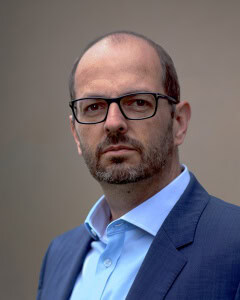
Insider Interview: A roadblock for counterfeit drugs?
pharmafile | July 8, 2019 | Feature | Business Services, Manufacturing and Production, Medical Communications, Research and Development, Sales and Marketing | Merck KGaA, blockchain, fake drugs, feature, pharma
Dr Thomas Endress, Founder, and Dr Frederic Berkermann, co-?Founder, of a new technology being developed at the Merck Innovation Center explain the benefits of a novel solution whixch leverages blockchain to reinforce drug counterfeiting precautions and countermeasures.
Can you provide a bit of background on blockchain and explain the basics of how it works?
Thomas: In particular, blockchain is a passport. The key feature is that you have snapshot-like security of certain supply transactions, authorisation transactions – anything which happens step-by-step could be captured. So if you look at a knowledge database, you have transactions – sending something from A to B to C – and you capture that, but you cannot be sure, if it comes to liability or something like that, that the database is not either attacked, or reverse engineered or changed at any time. That is the key advantage of blockchain mathematically – these changes are not possible anymore.
You have a certain kind of transactions – they are called blocks – and the blocks are usually kind of a snapshot photograph of the block, and all the actions in that block are frozen. Then, to the next block, where a photo of the first block is placed on top of the second, and this continues step by step by step: this is the chain. So you have these blocks of photos, and each of the photos have the beginning photo from the first block. Because these photographs are not mathematically changeable, you can ensure that whatever is written in these distributed databases remains forever – really, forever. That is the key advantage. That could be used, for instance, for money transactions, and that’s why it’s used for Bitcoin, but there are plenty of other use cases like logistics or smart contracts.
With that in mind, can you talk us through how Merck’s new system works?
Thomas: The pharmaceutical industry is affected, for instance, by counterfeits in the supply chain, and the supply chain needs to be safe. So we do our very best on that side to ensure that counterfeiting does not happen at Merck, and one of these countermeasures is that we have security materials which are included in our packages; that is industry standard, everybody’s doing certain security countermeasures. These security countermeasures are not accessible by the patients, they’re not accessible by authorities; they are there, but passage through checkpoints or whether somebody has checked these security features – that’s not written anywhere, and that’s where blockchain comes into the game. Blockchain, as a digital disruptor, means, on the one hand, that all the different parties up to the patient have access to a certain extent in future. On the other hand, all the checkpoints of these security features are captured.
Now, for the first time, we anchor that security material from a holistic approach, and talk to the entire supply chain system. That is the benefit we would like to provide. On top of that, it’s not only about the established security business, it’s about anchoring anything which stands for authenticity, and that could be DNA fingerprints, that could be a chemical pattern, that could be plenty of things we do in our lab business.
What would you identify as some of the key issues around counterfeiting of drugs within the industry’s supply chain?
Frederick: What clearly drives this, and is one of the major concerns, is that people are simply dying because of counterfeited or substandard drugs; the World Health Organization believes that this accounts for one in 10 medical products in developing countries. There’s also the economic impact that we, as an industry, are facing here. It’s hard to measure, but we coordinate internal analyses and the approximate revenue from counterfeited drugs is estimated at around 200 billion euros. Just to give you a good idea, this is more than what the top five pharma companies are generating in real revenue; it shows you that it is an industry by itself.
How exactly does the system address these issue?
Thomas: In very simple terms, moving step-by-step along the supply chain and along the value chain, there are pharmaceutical goods, and these goods have primary packaging and secondary packaging. Certain information from all of these levels is captured, and this information is then anchored in the blockchain. And within this anchoring, there we hold a bunch of patents, and their features are also entered into the blockchain. After entering them, they are tracked, step-by-step, along the supply chain.
After the anchoring, the respective pharmaceutical goods appear on a dashboard, so the corporate security officers, the supply chain security officers, they can follow their goods, not from a supply perspective, but more from a security perspective. There is a track and trace system that’s already established, and we come in with a plugin type of solution on top of it. Every attendee along the supply chain can have a look on their respective dashboards and see if something out of the ordinary has happened, and they can then follow up and undertake relevant countermeasures. We aim to roll it out during the summer months internally, and then capture the first in-field feedback results on it.
What other benefits can the system bring to the table?
Thomas: It’s planned that patients will be part of the entire system, that the patient will have the guarantee that certain checks have been undertaken along the chain, which they, right now, have not got access to because of data privacy issues. But with blockchain, we can ensure that they are not able to have the entire view of the supply chain; they only have access to confirm they have the right medications, and maybe additional information like patient adherence data could come in future.
That’s the patient side. On the blockchain side, that’s for liability, and that needs to be established over the next few years across the entire industry jointly, because of the power it provides. On top of that, why use a plugin type of solution alongside track and trace? It’s very simple: because track and trace is [huge]. Looking at digitisation, looking at machine-to-machine communication – it’s massive. In the track and trace system, what you are identifying is only a type of a barcode or a type of RFID tag, meaning you are tracking only the package and only the barcode, but you cannot be sure that the barcode is really linked to the real products; this link, this anchor – that is the uniqueness we would like to bring to the table. It does not replace track and trace – it makes track and trace even better and more fully utilised.
Is there an argument that use of the system could improve existing inefficiencies and generate cost-savings for healthcare systems?
Thomas: The supply chain topic is complex. If you look at innovative medicine, the supply chain is different than it is for the generic industry. That is exactly what we would like to reveal with our in-field pilots, because we believe that bringing security anchors to these track and trace capabilities, and these changes to machine-to-machine communications, have more potential. We have ideas of who can benefit, whether disruptive or non-disruptive, along the entire supply chain, and who maybe need to be incentivised, because they make extra effort contributing to the entire system.
We cannot name it and say ‘these five attendees will reap the benefit’ – it’s much too early to know. But that’s exactly where we need to have the community approach, and where we invite other attendees along the supply chain to work together to reveal to whom it’s really beneficial, because we’re convinced that anchoring something in the blockchain will disrupt certain processes, and that will lead to other incentivisations and benefits.
What are your plans for the system? Where do you plan to take it in future, and do you anticipate any particular challenges on that road?
Thomas: The are plenty of challenges! We are quite early on the blockchain track; if you look at our patents and patent applications, we have been doing it for more than two years now, and we have been faced by many challenges. The challenges we see for the near future relate to these collaborations: who will be part of the system? How can we use it alongside other blockchain systems from insurance companies, from transportation? Because they all concern the same object, the same pharmaceutical product. This is one major challenge, which we jointly invite the entire community and industry to discuss with us how we can solve it. Then we have to overcome these challenges, because we think there is much more in anchoring all these pharmaceuticals for anti-counterfeit reasons. We have touched on patient adherence, we have touched on the issue of dealing with recalls, we have touched on the issue of audit trails; in the future there will be things that we cannot even predict, but we would like if the entire industry discuss to whom it’s of benefit to have this huge digital anchor of pharmaceutical goods in the supply chain.
Related Content

LGC Group opens $100M Organic Chemistry Synthesis Centre of Excellence
LGC Group, a life sciences company, has opened its new Organic Chemistry Synthesis Centre of …

Johnson & Johnson announces successful results from trial for myeloma treatment
Global healthcare company, Johnson & Johnson, announced that analysis of its Darzalex (daratumumab) therapy showed …

Bend Bioscience adds commercial spray drying facility to Georgia site
Bend Bioscience has announced the addition of a commercial-scale spray dryer and a Gerteis dry …






